Monster Hunter World Iceborne: The Board Game Pre-Kickstarter Hands on
Monster Hunter World Iceborne: The Board Game takes the setting from Capcom’s 2019, Monster Hunter World expansion and brings it into the board game format as a lightly-compatible, playable stand-alone package following on from Steamforged’s phenomenal Monster Hunter World: The Board Game.
Kickstarting this month, Monster Hunter World Iceborne: The Board Game builds directly onto the gameplay style established by the core release: Prepare, Gather, Hunt, Harvest, Repeat. It’s a simple gameplay loop that perfectly encapsulates the risk-reward of Capcom’s long-running video game series. If you weren’t among the 20k backers that took Monster Hunter World: The Board Game to nearly 2300% of it’s £150k goal back in early 2021 when it funded in one day then you might not be aware of how that loop plays out in board game form, thankfully we were invited along to a press gathering where we walked through a scenario with the new game. We’re going to explain how it plays out here.
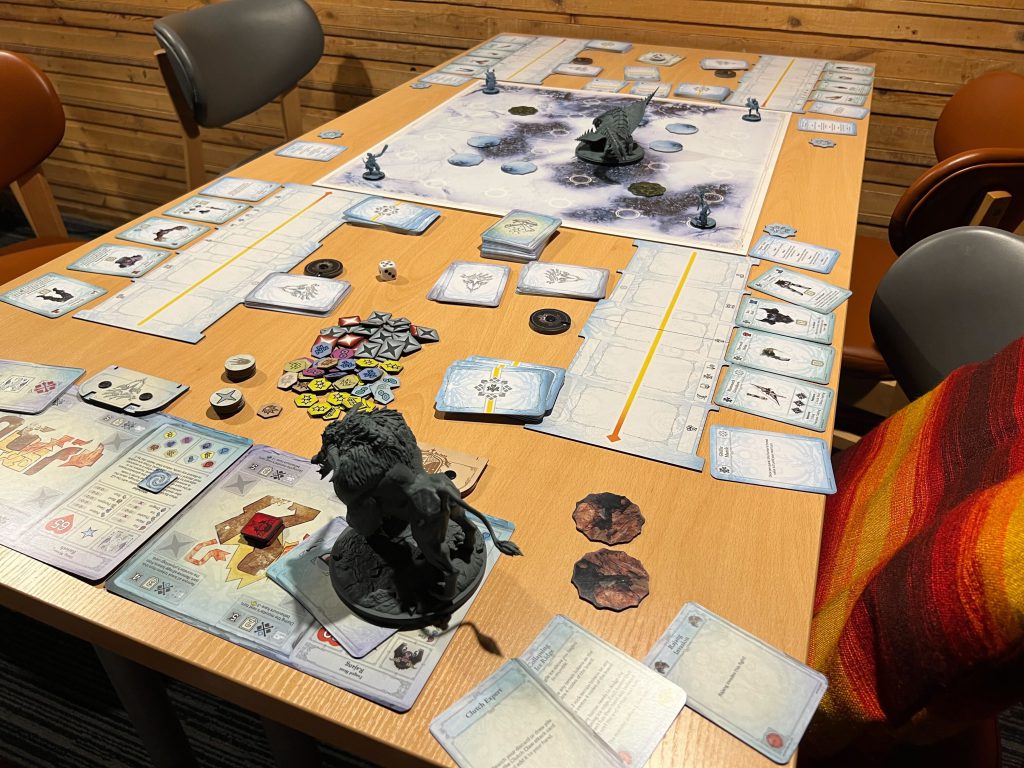
Firstly, much like the video game, Monster Hunter World Iceborne: The Board Game is about chipping away at a large enemy, carefully avoiding it as you slowly make a break in its armour and then land the killing blow. In this case, it plays out as a cooperative, two-to-four player, arena-based boss-battler, one which can be played as one-shot scenarios or in a vast campaign that runs through consecutively tougher monsters. Each time you beat an enemy you’ll get a chance to collect resources from it, which can then — in turn — be used to upgrade or overhaul your equipment, allowing you to specialise to your play style and refine your strategy.
The demonstration that we received was designed to cater to those who hadn’t played Steamforged’s previous outing and featured both a Gathering Phrase and Hunting Phase. In the case of the hunting phase, the four players in our group had already been set up for the scenario at hand. For The Gathering phase we all did something a little different, with the collective attendees voting their way through the choose-your-own-adventure style scenario set-up. In our case we evaded a bigger beast that was lurking around, however, because we didn’t do so appropriately some extra cards were added to the Turn Deck — a deck of events that play out through combat turns.
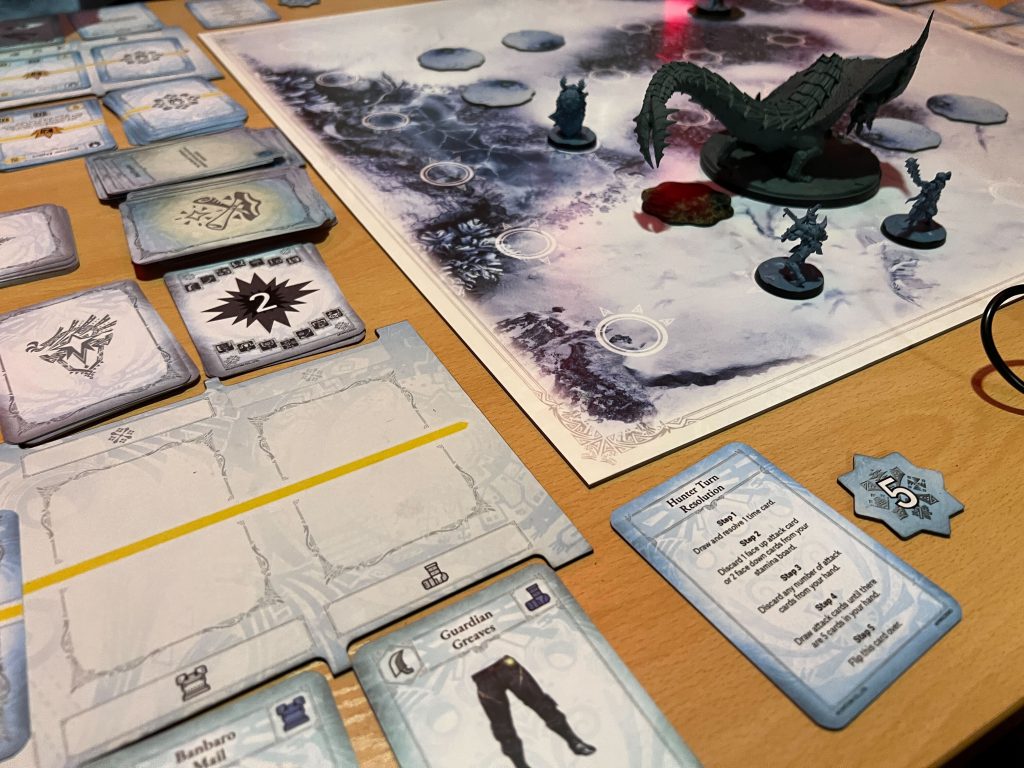
We then split off into groups, in our case we were a group of four players, but other tables had two or three players. Combat started immediately, with our quarry, a Barioth (A wyvern, sabre-toothed tiger beasty with a deadly sweeping tail attack) positioned in the middle of icy terrain. There’s a handful of different creatures to hunt in the core box, and Steamforged already has plans for expansions.
Each player had their own player board which included our equipment and weapons (as well as a Mantle, a very powerful item that can only be used once per quest). You also have a play board that holds your attack actions to track stamina, and a deck of attacks and damage. If you fill your stamina bar up too fast then you’ll be very limited in your actions and movements as you wait for them to discard over time, however, there’s a great risk-reward balance as more than a few attacks will do more damage, breaks or effects depending on how many face up or face down cards you already have on your board. I pulled off some very cool moves by carefully planning out my attacks, and while I wasn’t the greatest damage dealer with my Great Sword deck, I did manage to do a LOT of break damage to the barioth’s wings during our battle, which was pretty critical to our overcoming it.
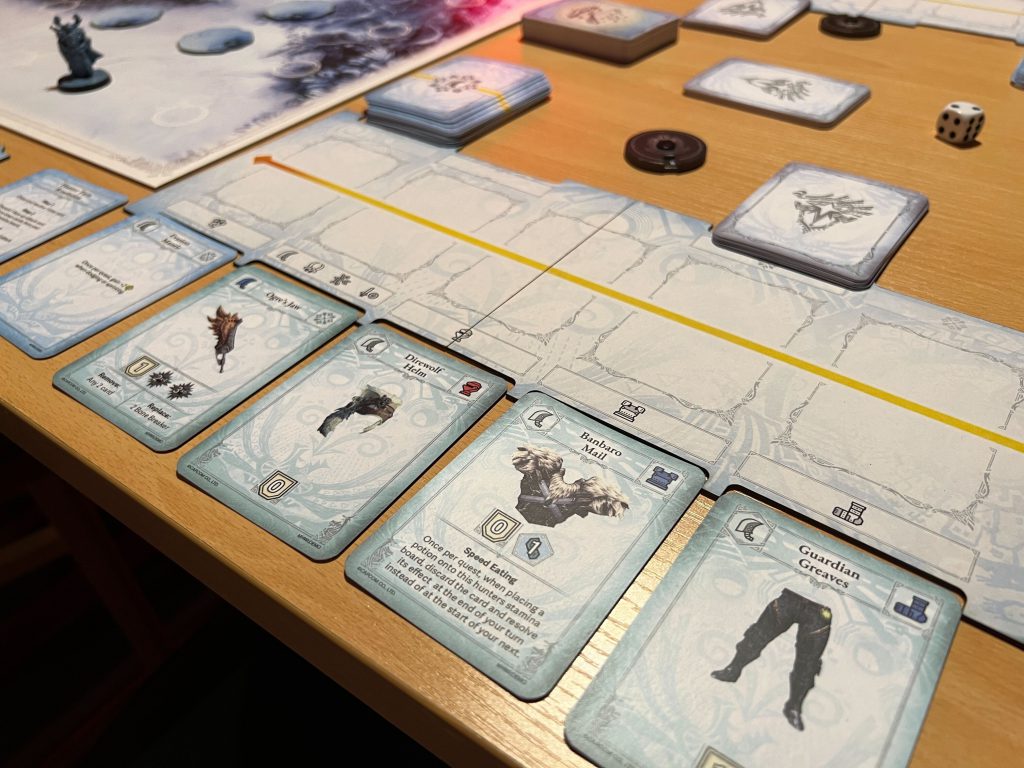
But, all four of us had different weapons, different specialities and all felt essential to the bringing down of the beast. It’s clear that a lot of balancing work has gone into it, perhaps beyond anything else, and that’s essential because the Monster Hunter series is all about a delicate balance and delicate timing, and that’s a hard thing to convert to a board game medium. After a few turns we were all planning ahead, discussing our turns and debating who should go between the next enemy round. This level of communication is core, not just because enemy attacks can be deadly but because of Monster Hunter World Iceborne: The Board Game’s turn system.
While a lot of board games have an ‘IGOUGO’ movement system, here there are two factors at play. Firstly, each player gets a go before a player can have their second. Secondly, the enemy’s behaviour cards define how many players go after their turn. For its turn the barioth would draw a card, that then indicates which player it will target (furthest away, highest threat, nearest, etc), how and how far it will move, the way it will face and how it will attack. In most cases all of these things happen, however, there is a secondary stack of behaviours in its pile, symbolising an enraged or panicked mood, where it attacks in a different way. Some of these attacks will have a wind-up, or in the barioth’s case, create a whirlwind that when resolved will damage anybody near it.
They’re big, fate-swinging behaviours, and even a single hit can knock down a player if it connects. This is where Face Down attack cards come in, players can dodge out of the way by flooding their stamina tracker with cards corresponding to the damage, and they get free moves for doing so. If you don’t dodge then you, simply, take the damage, and might find yourself having to use the limited supply of healing potions once back up on your next turn. Big sweeping attacks from the monster can leave your team decimated, and having the majority of your hunting team unconscious is the failure trigger for a hunt. This dodging method is a great way to keep the fight going, however if you burn through your attack deck then you need to use a whetstone, which there are no limits on, but take a long time to use, during which you’re not only out of the action but also very vulnerable.

Once the monster has moved, the players then check the number of players that get to go next. In some of our cases, it was just one. That was incredibly tense. The player who does go can then move around the board and lay out some attacks in order to try and damage the beast. Some of your attack cards will also allow you to move, which is a great way to close the distance on an enemy, or skirt around the side to attack a weaker spot (there are several areas you can target on the monster, and each one has its own effects when broken). Once done the player draws a Time Card, discards a face-up card (or two face-down cards) from their stamina pile, chooses if they want to discard from their attack hand and redraws their attack hand up to five.
Time Cards are like micro-events, they can cause player Threat — which is how the monster decides who to target at times — to switch, as well as shift the monster behaviour or subvert other rules. However, as we’d ground our way through the barioth’s health, dropping it to about 20 health from its generous 65 starting health, we drew a card that brought an invader to our battle. This feature is new to Monster Hunter World Iceborne: The Board Game, and meant that an incredibly angry Jarroth (giant angry nightmare bull, 80hp) burst onto the scene. At this point, the Jarroth took a turn immediately after the barioth did, but thankfully for us the hunt ended on the death of the barioth, and the Jarroth didn’t have any sort of alliance to it, instead totally finishing it off for us across two nail-bitingly intense rounds.
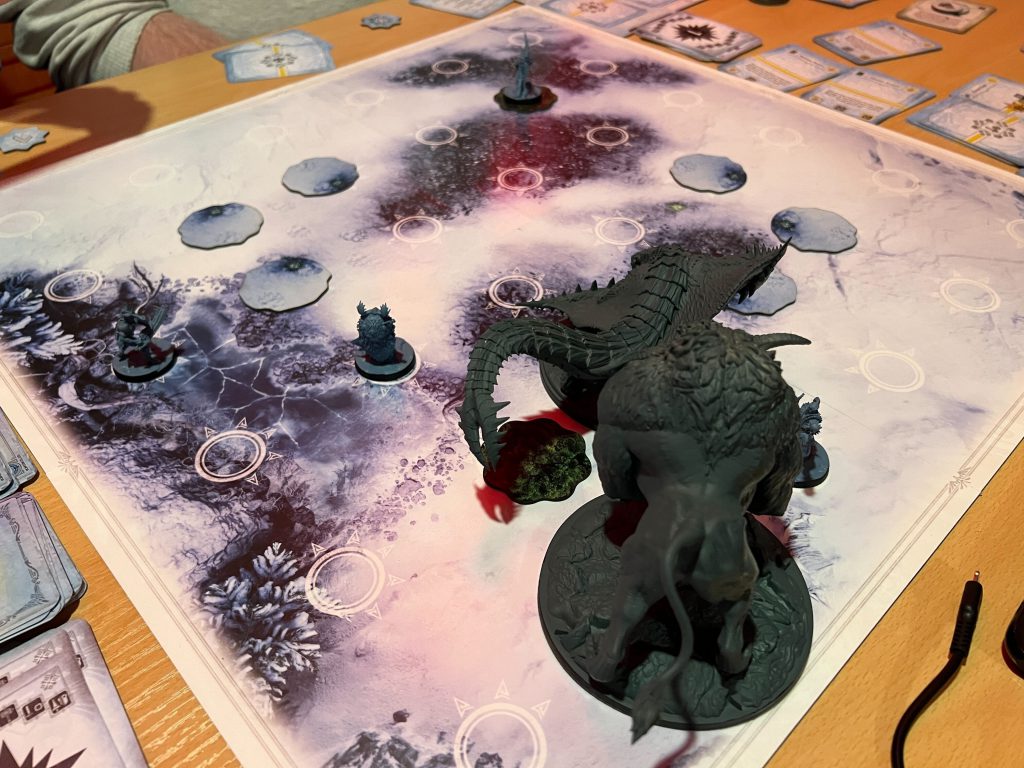
The Jarroth, unlike us, was regularly doing more than 4-5 damage on each of its turns, and it made light work of our target as we expertly stayed the hell away from it.
What else? Well, while we didn’t get to share in the spoils, as our demo ended, there are more than a few other standout features that I want to talk about. For a start, the attention to detail regarding the IP is really impressive: All of the armour and weapon designs have clearly been lifted straight from the game, it even uses the same iconography and colour-coding to explain the mastery level of the weaponry and symbolise the creature and how it attacks. I love the tightly-packed art symbols for the monsters in the Monster Hunter series, it’s a great stylistic choice but also says — without words — that there’s been a millennia-long conflict against these giant monsters, and that you’re part of a long, exhausting struggle to survive.
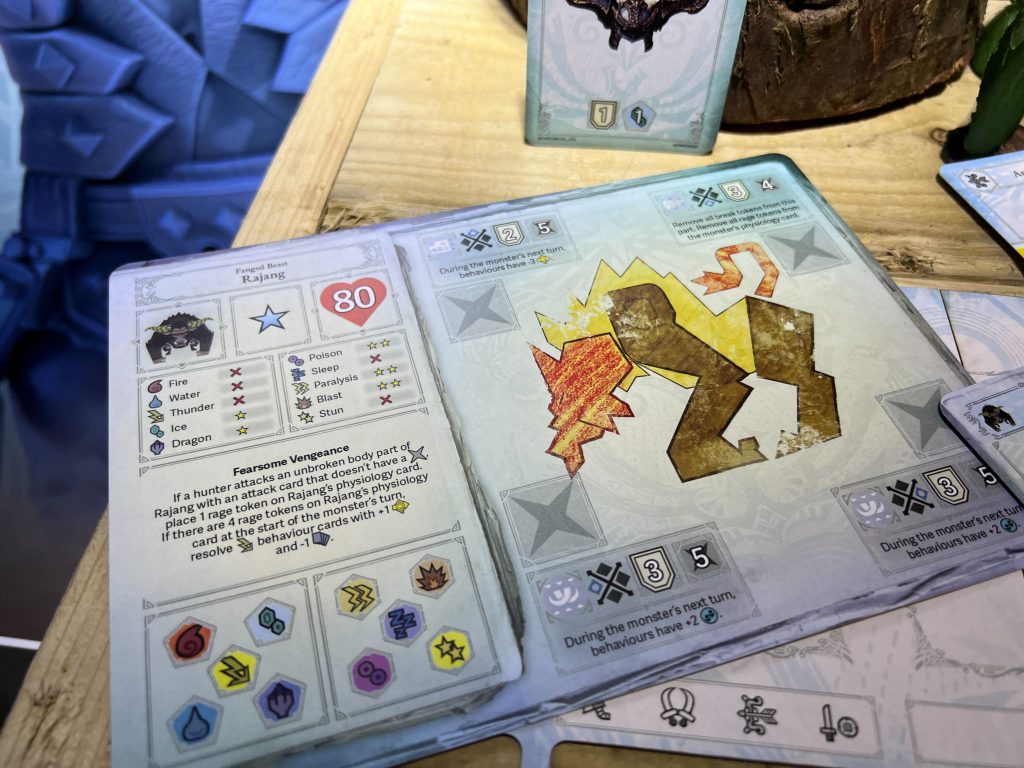
While I didn’t play the original game, in fact, even the Kickstart backers didn’t get their hands on it until earlier in the year, the developers outlined some of the major changes to the formula beyond the frosty setting. For a start, the limited potions are a new addition, you’d instead have burned through time cards and returned at full strength, something that would have massively lowered the chance of the monster Turf War that we experienced. Turf War was also new, although it was originally intended to be in their first outing. As well as that, several new pieces of equipment have been added in, including ear plugs that are essential against a screeching enemy, and the Clutch Claw which, if used intelligently, can vault a player directly into a monster, giving the perfect opportunity for high-damage combos.
Apparently, there were a few more tweaks to be made before the Kickstarter kicked off, but the thing that compelled me the most (beyond the campaign gameplay) was that Lead Designer Jamie Perkins stated that while the original Monster Hunter World board game and Iceborne were designed to be individual, there’s enough in common between the two that players could bolt monsters from the first game into Iceborne, leaving speculation as to whether somebody could muster a homebrew, mega campaign. That, to me, sounds really exciting.
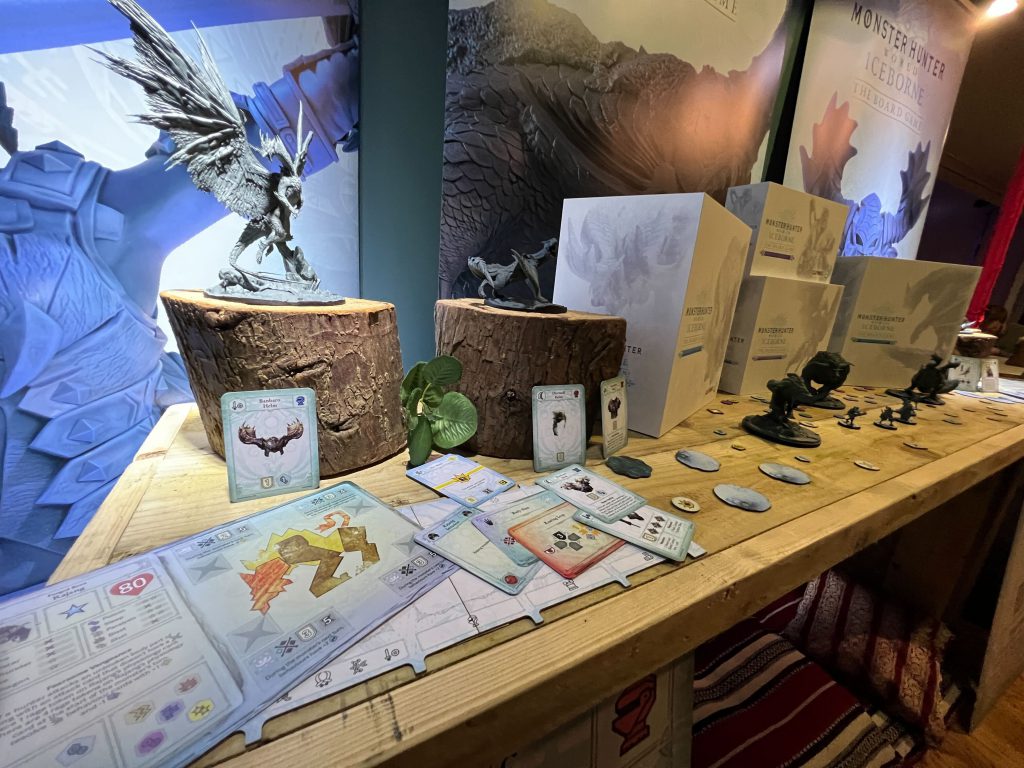
If you’re looking for a tight, tense cooperative campaign then you don’t need to look much further than Monster Hunter World Iceborne: The Board Game.
The Monster Hunter World: Iceborne Kickstarter will open on May 18.
Jarroth?